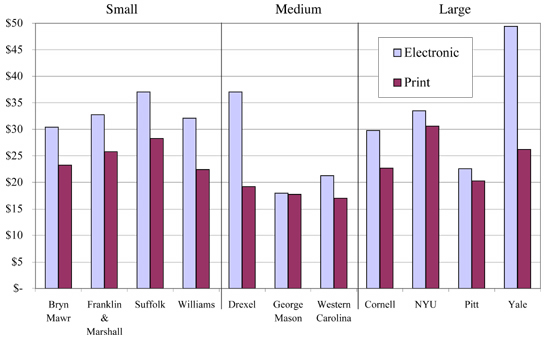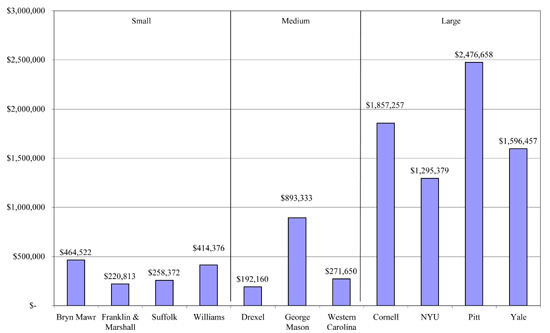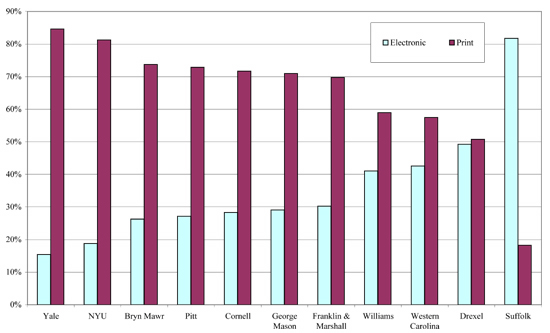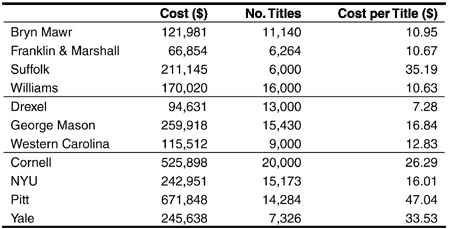In the past decade, as periodicals in the electronic format have increased in importance for research and teaching, academic libraries have adapted to make them available locally. In this section, we provide an overview of the 11 participating libraries and their periodicals operations. We examine collection profiles and the staff activities that make them possible, paying particular attention to tasks that contribute to long-term preservation. We consider the possible differences in staffing levels between the formats. Finally, we provide an overview of the annual nonsubscription budgets of each library and the percentage of annual expenditures on each format.
Periodicals Collections Profiles
During the period under observation, most of the current periodicals collections in the participating libraries contained a mixture of items in print and electronic formats. The small- and medium-size libraries have large electronic collections relative to their print collections. Drexel and Suffolk have moved almost entirely to electronic-only collections. The large libraries have roughly similar numbers of print and electronic titles, with the exception of Yale, the participating collections of which were its principal humanities and area studies collections. Every library under examination provides access to at least 5,000 electronic periodicals titles. Nevertheless, as figure 1 illustrates, major differences exist both within and across the library size categorizations in the size and format focus of periodicals collections.
For each library, the choice to accession significant numbers of electronic titles to replace or complement an existing print collection has necessitated new processes and resources. How do processes differ between the two formats?
Time Expenditures
Our data allow us, in figure 2, to provide the aggregate number of staff hours expended at the 11 libraries on each of the 14 activities, by format. The hours for both electronic and print include both current issues and backfiles. These aggregate figures are not weighted by institution; therefore, the larger libraries account for the majority of hours. The aggregates also mask significant differences among the individual libraries. They are intended solely to provide a sense of how processes tend to differ.25 Overall, 73% of the total periodicals-related hours at these libraries are devoted to the print format.


Fig. 2. Total periodicals-related hours expended by all libraries, by activity and by format
These hours are distributed very differently within each format. Major print activities on which far fewer hours are expended for the electronic format than for the print include subscription processing, receipt and check-in, cataloging, physical processing, stacks maintenance, and circulation. For only two activities (negotiations and licensing and user instruction) were more hours expended on the electronic format than on the print.
The data in figure 2 include time expenditures on some activities that might not have been expected. In some cases, such as “receipt and check-in” and “circulation,” our activity definitions (see Appendix B) can be understood to encompass electronic activities. And although “linking” activities are generally thought of as related exclusively to the electronic format, some libraries attempt to include information about their print collections in their linking services. Finally, in the case of physical processing, it is difficult to understand why there should be any hours for the electronic format, so the miniscule number of hours appearing there may be in error. Overall, however, we believe that these data present an accurate illustration of the annual time expenditures for library periodicals operations.
Masked behind these activities for the print format are important tasks that contribute to the long-term preservation and availability of the periodicals. Binding, which many view as an important factor in making print backfiles more secure and durable, as well as rebinding and security stripping, are managed by staff as part of physical processing. Various kinds of shifting, transferring, and shelf maintenance are integral to the continued availability of the print backfiles and are grouped under stacks maintenance. Searching for missing items is included as part of circulation, and if a replacement volume must be purchased, it will affect the library’s operations under collections development, subscription processing, receipt, and cataloging. Finally, some 2,500 hours per year are devoted to professional preservation activities, including reformatting, conservation, and disaster recovery. In short, while it is impossible to segregate preservation-related hours within the print format, they are many, and they suffuse quite a number of the activities.
The same is not true for the electronic format. We were able to identify only 350 hours under “preservation,” and no operational electronic-preservation programs are in place. To be sure, there is some modest related work to be found in some of the other activities. But in terms of breadth and depth, the amount of work to ensure the long-term availability of electronic periodicals does not match that of the print format. Storage and maintenance of electronic collections have become the work of the publisher and are largely paid for by licensing fees, even if long-term archival responsibility has not yet been assigned.
In addition to these total hours, we calculated the time expenditure per title. This measure, illustrated in figure 3, is intended to provide some further perspective about the relative time expenditures involved with each format; again, however, this measure is an aggregate that is not weighted by institution and that masks differences among the libraries.


Fig. 3. Minutes of staff time expended per title on various periodicals-related activities, average across all participating libraries
One important reason for differentials in per-title time expenditure among libraries could well be usage. Two libraries with identical collections, seeking to provide identical services for their readers, might experience different levels of usage of their collections, and this would have an impact on the cost of activities such as circulation, reference, and user instruction. Variances in time expenditures between the formats for these three activities may therefore be explained, at least in part, by differences in the levels of usage of the formats. In the life-cycle section, we take account of this possibility, but we did not attempt to measure usage directly or to adjust costs on this basis.
The patterns of time expenditures per title are generally consistent with expectations. The format comparison suggests a significant shift away from the print format’s manual tasks, including subscription processing, receipt and check-in, physical processing, stacks maintenance, and circulation.26 Collection development and cataloging also required far less time per title in the electronic format. But the fact that these activities took less time does not tell us anything about their cost. A significant factor in cost is the compensation of staff performing each of these activities. We therefore will now examine the average staff compensation for periodicals operations.
Average Compensation Rates
Electronic-resources staff are sometimes believed to be more highly skilled and to work in positions with higher classification levels than do print-focused staff. Although we did not collect data on classification levels per se, our cost data provide insight into and help confirm this hypothesis. Figure 4 illustrates average hourly staff compensation rates for the two formats at each library.27 The figure indicates that hourly staff compensation for activities in the electronic format is at least marginally higher than it is for print at all 11 libraries, and at 8 of the libraries the difference exceeds 20%. This pattern holds true in virtually all activities that apply to both formats.

Fig. 4. Staff costs per hour, by library by format
There are two reasons why electronic-format operations tend to rely on staff who are better paid than print operations staff. The first reason is that, as the previous section indicated, major differences exist in the types of activities performed for each of the two formats. The activities for the print format that are not necessary for the electronic format, including receipt and check-in, physical processing, stacks maintenance, and circulation, are generally performed by clerks or student workers. For several activities, one group of staff performs these activities for one format, and another group of staff performs similar activities for the other format. Within cataloging, for example, various processes have been developed to allow clerks to perform most of the work for the print format; but for the electronic format much of the cataloging has been done, at least until relatively recently, by professional librarians. This example suggests one area where new processes might yield further economies, at least for certain libraries, in the electronic format.
Capital Costs
Another key cost area related to periodicals is space to process and store collections. Secure and environmentally appropriate storage space is one of the most important components of the archiving solution for periodicals in print format, and even at high-efficiency off-campus rates, it is an important ongoing cost. The print format relies more heavily on space than does the electronic format. The cost of physical space is therefore an area that will offer savings in the electronic format relative to the print format.
The expenses associated with providing adequate storage space include construction, renovation, maintenance, and utilities. The costs of construction and renovation (as well as, in many cases, maintenance and utilities) generally come from outside the library budget. Capital spending for construction and renovation is generally budgeted for on an institution-wide level, and maintenance and utilities may likewise not appear on the library budget. So, although storage needs and the associated costs are lower for the electronic format than they are for print, much of the savings will accrue to the institution rather than within the library budget itself. This is an important factor in the consideration of whether any overall savings can be realized by the library and redeployed for other purposes.
Annual Nonsubscription Costs
To summarize the data on total annual nonsubscription costs presented in this section, we provide an overview of the total scale, across all holdings categories, of periodicals operations at each of the participating libraries. We include all cost components, including capital costs that may not appear on the library budget. Figure 5 shows that major differences of scale emerge both within and across our size categorizations. Note that these totals include only the collections referenced in table 2 and therefore are not necessarily institution-wide totals.

Fig. 5. Total annual nonsubscription periodicals cost allocation, by library
The most important reasons for these differences are the size and composition of the holdings of the various collections, along with patterns of usage. Differences in the processes used to perform similar activities also play a significant role, as do variations in salaries and benefits. Within these libraries, the breakdown of costs by format exhibit striking differences. That is, within the total annual nonsubscription costs shown in figure 5, the allocations among the formats were vastly different. These allocations are shown in figure 6, in which the libraries are ordered by their percentage allocation to the electronic format.

Fig. 6. Share of total annual nonsubscription periodicals costs by format, by library
The two schools with the highest electronic allocations, Drexel and Suffolk, have already moved from print to electronic format, as can be seen in figure 6. Several of the larger schools, notwithstanding the presence of significant numbers of electronic periodicals on their campuses, appear to continue to devote high proportions of their expenditures to their formidable backfile collections. Yale appears furthest to the left because its collections represented in this study are humanities and area studies alone, and periodicals in these fields are least likely to be available in electronic format.
We now break down the data presented in the previous figures in greater detail. We report the annual total nonsubscription costs by holdings category in tables 3 through 5.
In this section, we have examined some of the evidence suggesting that format differences lead to different library operations and costs. These data might be thought of as budgetary in nature, in that they provide information on the time allotments and costs for a recent year. In the next section we will use a different analytical lens. We will use the budgetary data to project the likely cost implications of the transition itself.

Table 3. Total annual nonsubscription cost allocated to electronic periodicals, per title

Table 4. Total annual nonsubscription cost allocated to current issues of print periodicals, per title

Table 5. Total annual nonsubscription cost allocated to backfiles of print periodicals, per volume
FOOTNOTES
25 It is not possible to provide breakdowns for individual libraries by activity and by format because in many cases a given figure would represent the work of an individual staff member and would conflict with the assurances of confidentiality that we offered during the data-collection process.
26 It is important to recognize that there are variations in the processes adopted at each library for both formats. Recent literature, for example, suggests that some libraries have been rethinking the necessity of binding for print periodicals (see Anderson and Zink 2003 and Streatfield and King 2003). And for electronic periodicals, processes are in the relatively early stages of being developed (see Watson 2003 for one overview).
27 Hourly rates for salaried employees were calculated by dividing compensation by a self-reported number of hours. Salaried employees who do not receive overtime compensation can thereby appear to earn a relatively low hourly rate. Compensation rates include benefits but exclude overhead.
